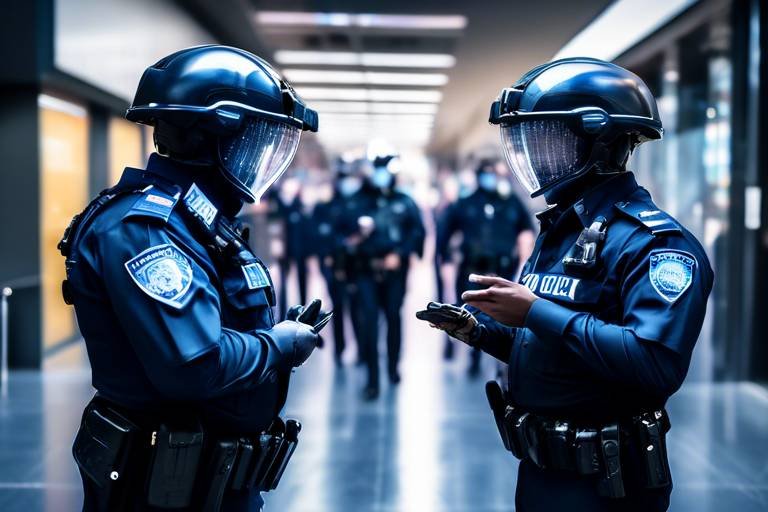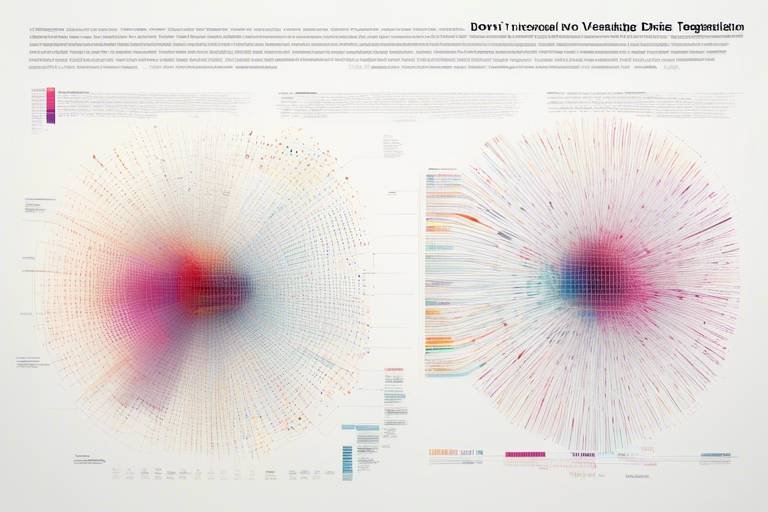The Role of AI in Predictive Policing
Artificial Intelligence (AI) is rapidly changing the landscape of law enforcement, particularly through a method known as predictive policing. Imagine having a crystal ball that can forecast where crimes are likely to occur, helping police departments allocate resources more effectively and ultimately reduce crime rates. This innovative approach leverages vast amounts of data, advanced algorithms, and machine learning techniques to identify patterns and trends that might otherwise go unnoticed. But what does this really mean for our communities? Is it a step towards safer neighborhoods, or does it raise ethical dilemmas that we need to address? In this article, we will explore how AI technologies are transforming law enforcement practices, enhancing crime prevention, and the ethical considerations that come along with it.
Predictive policing is not just about numbers and algorithms; it's about people and communities. It aims to create a proactive approach to law enforcement, shifting from traditional reactive methods to a more strategic, data-driven model. By analyzing historical crime data, social media interactions, and even weather patterns, law enforcement agencies can predict where crimes are likely to happen. This allows them to deploy officers to high-risk areas before incidents occur, potentially preventing crime before it happens. However, the success of this approach hinges on the quality and breadth of the data collected.
As we dive deeper into the role of AI in predictive policing, we will uncover the various technologies that are making this possible, the data collection methods employed, and the ethical considerations that must be taken into account. From the challenges of data quality to the implications for privacy and community relations, it’s clear that while the benefits of predictive policing are compelling, they come with significant responsibilities. Join us as we navigate this complex landscape, exploring the intersection of technology, law enforcement, and society.
- What is predictive policing? Predictive policing is a data-driven approach that uses algorithms to forecast potential criminal activities based on historical data and patterns.
- How does AI enhance predictive policing? AI enhances predictive policing by analyzing large datasets to identify trends and patterns that can inform law enforcement strategies.
- What are the ethical concerns surrounding predictive policing? Ethical concerns include issues of privacy, potential biases in data, and the impact on community trust in law enforcement.
- Can predictive policing reduce crime rates? Studies have shown that predictive policing can lead to reductions in certain types of crime, but its effectiveness can vary based on implementation and community engagement.

Understanding Predictive Policing
Predictive policing is a revolutionary approach that leverages data analysis to anticipate potential criminal activities before they occur. Imagine having a crystal ball that not only sees the future but also helps law enforcement agencies allocate their resources more effectively. This concept is gaining traction as police departments around the globe look for innovative ways to combat crime. By analyzing historical crime data, social media trends, and even geographical patterns, predictive policing aims to identify hotspots where crimes are likely to happen. But how does this all work?
At its core, predictive policing employs a variety of methodologies that include statistical analysis, machine learning, and data mining. These techniques allow law enforcement to sift through enormous amounts of data and extract meaningful insights. For instance, if a particular neighborhood has seen a spike in burglaries during the summer months, algorithms can flag this trend, prompting police to increase their patrols in that area. This proactive approach not only helps in crime prevention but also optimizes the use of police resources.
One of the foundational concepts of predictive policing is the idea of risk terrain modeling. This technique involves mapping out areas that are more susceptible to crime based on various factors such as socio-economic status, urban design, and previous crime reports. By doing so, law enforcement can create targeted strategies that address the root causes of crime rather than merely responding to incidents as they occur. It's like having a GPS system for crime prevention—directing resources to where they are most needed.
However, understanding predictive policing is not just about the technology; it's also about the data that fuels it. The effectiveness of predictive policing hinges on the quality and comprehensiveness of the data collected. This includes a wide array of information, such as:
- Crime reports and statistics
- Social media activity
- Geographical information systems (GIS)
- Demographic data
These data points help create a well-rounded picture of crime trends and potential threats. But, as we delve deeper into this subject, we must also consider the ethical implications and challenges that come with such an approach. After all, while the goal is to enhance public safety, we must ensure that we do not infringe upon individual rights or reinforce existing biases in the system.
In summary, predictive policing represents a significant shift in how law enforcement agencies operate. By harnessing the power of AI and data analysis, police departments can become more proactive rather than reactive. However, as we embrace this innovative approach, it's crucial to navigate the complexities of data ethics, community trust, and accountability to ensure that predictive policing serves its intended purpose without compromising justice.

AI Technologies in Use
In the realm of predictive policing, the integration of artificial intelligence (AI) technologies has revolutionized how law enforcement agencies operate. By leveraging advanced algorithms and data analysis techniques, these agencies can better anticipate criminal activities, ultimately leading to more effective crime prevention strategies. But what exactly are the AI technologies at play in this transformative process?
One of the primary technologies driving predictive policing is machine learning. This subset of AI enables systems to learn from data patterns and improve their predictions over time without being explicitly programmed. For instance, machine learning algorithms can analyze historical crime data, identifying trends and hotspots that might not be immediately obvious to human analysts. This allows police departments to allocate resources more efficiently, focusing their efforts on areas that are statistically more likely to experience criminal activity.
Another critical component is data mining, which involves extracting valuable insights from vast amounts of data. In predictive policing, data mining techniques sift through various datasets, including crime reports, social media interactions, and demographic information. By uncovering hidden correlations and patterns, law enforcement can gain a deeper understanding of the factors contributing to crime in specific areas. This holistic view is essential for developing targeted interventions that address the root causes of criminal behavior.
To illustrate the impact of these technologies, consider the following table that summarizes some of the key AI tools used in predictive policing:
| AI Technology | Description | Application |
|---|---|---|
| Machine Learning | Algorithms that learn from data patterns and improve over time. | Crime trend analysis and resource allocation. |
| Data Mining | Extracting insights from large datasets. | Identifying correlations between crime and social factors. |
| Predictive Analytics | Using statistical techniques to forecast future events. | Predicting potential crime hotspots. |
| Geospatial Analysis | Analyzing geographic data to understand crime patterns. | Mapping crime occurrences for strategic planning. |
Moreover, the utilization of predictive analytics plays a significant role in forecasting future crime incidents. By applying statistical models to historical data, law enforcement agencies can predict where and when crimes are likely to occur. This proactive approach not only helps in resource allocation but also empowers officers to engage with communities before issues escalate.
Lastly, geospatial analysis is another vital tool in the predictive policing toolkit. By mapping crime data onto geographic locations, police can visualize trends and patterns that inform their strategies. This spatial awareness is crucial for understanding the environmental factors that contribute to crime, allowing for more effective community engagement and intervention efforts.
In summary, the deployment of these AI technologies in predictive policing is reshaping the landscape of law enforcement. From machine learning to geospatial analysis, each tool brings a unique capability that enhances the accuracy and effectiveness of crime prevention strategies. However, as we embrace these innovations, it's essential to remain vigilant about the ethical implications and ensure that the deployment of AI in policing is both responsible and equitable.
- What is predictive policing? Predictive policing is a data-driven approach that uses algorithms to forecast potential criminal activities based on historical data and trends.
- How does machine learning improve policing? Machine learning algorithms analyze vast amounts of data to identify patterns and trends, allowing law enforcement to allocate resources more effectively.
- What are the ethical concerns surrounding AI in policing? Ethical concerns include potential biases in data, privacy issues, and the need for transparency and accountability in AI algorithms.

Data Collection Methods
In the realm of predictive policing, data collection is the cornerstone that supports the entire structure of crime forecasting. It’s akin to building a house; without a solid foundation, everything else is at risk of collapse. Law enforcement agencies leverage a variety of data sources to create a comprehensive picture of potential criminal activities. These data sources can be broadly categorized into several types, each playing a unique role in shaping predictive models.
One of the primary sources of data is crime reports. These reports provide historical data regarding where and when crimes have occurred, which is essential for identifying patterns. For instance, if a particular neighborhood experiences a spike in burglaries during certain months, this information can be invaluable for predicting future incidents. Additionally, police departments often utilize social media activity as a modern tool for gathering insights. With the rise of platforms like Twitter and Facebook, users frequently share their thoughts and experiences related to crime and safety, offering law enforcement a real-time glimpse into community sentiments.
Moreover, geographical information plays a pivotal role in data collection. Geographic Information Systems (GIS) allow police to visualize crime trends on maps, helping them identify hotspots where crimes are more likely to occur. By analyzing spatial data, law enforcement can allocate resources more effectively, ensuring that patrols are concentrated in areas that need them the most. This targeted approach not only enhances crime prevention efforts but also optimizes the deployment of police personnel.
However, it’s important to note that the effectiveness of predictive policing hinges on the quality and comprehensiveness of the data collected. Inaccurate or incomplete data can lead to misguided predictions, which can ultimately undermine public trust in law enforcement. Therefore, agencies must ensure that they are utilizing reliable data sources and continuously updating their databases to reflect the most current information available.
In summary, the methods of data collection in predictive policing are multifaceted and critical for the success of crime prevention strategies. By harnessing the power of crime reports, social media, and geographical data, law enforcement agencies can create a robust framework for anticipating criminal activities. Yet, as we delve deeper into the world of predictive policing, we must also remain vigilant about the challenges and ethical considerations that come with it.

Challenges in Data Quality
When it comes to predictive policing, the accuracy of forecasts heavily relies on the quality of data being used. However, the road to achieving high-quality data is often riddled with obstacles. One of the most significant challenges is the presence of biases within the data. For instance, if historical crime data reflects systemic biases, such as over-policing in certain neighborhoods, it can lead to skewed predictions that unfairly target specific communities. This is akin to trying to find your way using a map that only shows certain roads while ignoring others; the result is a distorted view of reality.
Moreover, inaccuracies in data collection can further complicate matters. Errors may arise from various sources, including human mistakes in reporting crimes or technical glitches in data management systems. Imagine trying to predict the weather based on faulty sensors; the outcome would undoubtedly be unreliable. Similarly, inaccuracies in crime data can produce misleading predictions, which in turn affect law enforcement strategies.
Another critical factor is the gaps in data. Not all incidents are reported, and some communities may lack sufficient data due to underreporting or a lack of trust in law enforcement. This absence of comprehensive data can create blind spots in predictive models, making it challenging to accurately forecast crime patterns. It’s like trying to complete a puzzle without all the pieces; the final picture remains incomplete and unclear.
To tackle these challenges, law enforcement agencies must implement rigorous data validation processes. This includes regular audits of data sources, training for personnel on accurate reporting, and the adoption of advanced technologies that can help mitigate human errors. Additionally, fostering community trust is essential, as it encourages more people to report incidents, thus enriching the data pool. Ultimately, addressing these data quality challenges is crucial for enhancing the effectiveness of predictive policing and ensuring fair and just law enforcement practices.
- What is predictive policing? Predictive policing is a data-driven approach that uses algorithms to forecast potential criminal activities based on historical data.
- How does AI improve predictive policing? AI enhances predictive policing by analyzing vast amounts of data quickly and identifying patterns that human analysts might miss.
- What are the ethical concerns surrounding predictive policing? Ethical concerns include issues of bias, privacy, and the potential for reinforcing systemic inequalities in law enforcement.
- How can data quality issues be addressed? Data quality can be improved through rigorous validation processes, community engagement, and the use of advanced technologies.

Privacy Concerns
As we dive deeper into the realm of predictive policing, one of the most pressing issues that emerges is the question of privacy. With law enforcement agencies harnessing vast amounts of data to predict criminal activities, the line between ensuring public safety and infringing on individual rights becomes increasingly blurred. Imagine living in a world where your every move, every conversation, and every online interaction is monitored by algorithms designed to keep you safe. Sounds a bit dystopian, doesn’t it?
At the heart of the privacy debate is the sheer volume of data collected. Police departments often gather information from various sources, including:
- Crime Reports: Historical data on criminal activities in specific areas.
- Social Media Activity: Posts and interactions that may indicate potential criminal behavior.
- Geographical Information: Data on locations with high crime rates to inform patrol strategies.
While this data can be invaluable for predicting crime hotspots, it also raises significant concerns about the surveillance culture it fosters. For instance, how can we ensure that the data is used ethically and not to profile or target specific communities unfairly? The potential for bias is a major concern, as algorithms are only as good as the data fed into them. If the data reflects systemic biases—such as disproportionate policing in certain neighborhoods—then the outcomes can perpetuate and even exacerbate these issues.
Moreover, there’s the question of consent. Many individuals are unaware that their data is being collected and analyzed by law enforcement agencies. This lack of transparency can lead to a sense of distrust between communities and the police. How can citizens feel safe when they are unaware of how their information is being used? It’s a complex web of ethical dilemmas that begs for clear guidelines and stringent regulations.
To address these concerns, it’s essential for law enforcement agencies to implement robust policies that prioritize data privacy. This includes ensuring that:
- Data collection practices are transparent and openly communicated to the public.
- Individuals have the right to access their data and understand how it is being used.
- Strict measures are in place to prevent data misuse and unauthorized access.
As we continue to explore the intersection of technology and policing, it’s crucial to strike a balance between utilizing AI for crime prevention and safeguarding the privacy rights of individuals. After all, a society that values freedom and privacy should not have to compromise these principles in the name of safety.
Q: What is predictive policing?
A: Predictive policing is a data-driven approach that uses algorithms and historical crime data to forecast potential criminal activities and allocate resources accordingly.
Q: How does AI enhance predictive policing?
A: AI technologies, such as machine learning and data mining, analyze patterns in data to improve the accuracy of crime predictions.
Q: What are the privacy concerns associated with predictive policing?
A: The collection of vast amounts of data raises issues related to surveillance, consent, and the potential for reinforcing systemic biases.
Q: How can law enforcement ensure ethical use of data?
A: Agencies should implement transparent data collection practices, allow individuals access to their data, and establish strict guidelines to prevent misuse.

Impact on Crime Rates
The impact of predictive policing on crime rates has been a topic of intense debate among law enforcement agencies, policymakers, and the public. At its core, the goal of predictive policing is to utilize advanced algorithms and data analytics to identify potential crime hotspots before incidents occur. This approach aims to not only reduce crime but also to optimize the allocation of police resources. But does it actually work? The evidence is mixed, and understanding the nuances is crucial.
Several studies have indicated that predictive policing can lead to a measurable decrease in crime rates, particularly in urban areas where crime tends to be more concentrated. For instance, a report from the RAND Corporation highlighted that cities employing predictive policing strategies saw a reduction in property crimes by up to 30% in certain neighborhoods. This suggests that when law enforcement agencies leverage data effectively, they can preemptively address potential criminal activities, thereby enhancing public safety.
However, it’s important to note that the effectiveness of these strategies can vary significantly based on implementation and the specific algorithms used. For example, a study conducted in Chicago revealed that while certain districts saw a drop in violent crimes, others experienced no change or even an increase. This inconsistency raises questions about the reliability of predictive models and their real-world applicability.
Moreover, the impact of predictive policing on crime rates is not solely about numbers. It also involves the perceptions of safety within communities. When residents feel that law enforcement is effectively using data to prevent crime, their trust in police can strengthen. Conversely, if predictive policing leads to over-policing in certain neighborhoods, it can foster resentment and fear, potentially driving a wedge between communities and law enforcement. Therefore, a delicate balance must be struck between proactive policing and maintaining community trust.
To further illustrate the impact of predictive policing on crime rates, consider the following table summarizing key findings from various studies:
| Study | Location | Crime Type | Impact on Crime Rate |
|---|---|---|---|
| RAND Corporation | Los Angeles | Property Crimes | Reduction of up to 30% |
| Chicago Study | Chicago | Violent Crimes | Varied results; some areas decreased, others increased |
| University of California | Oakland | Theft | Reduction by 20% |
In conclusion, while predictive policing has the potential to positively impact crime rates, it is not a one-size-fits-all solution. The effectiveness largely depends on the context in which it is applied, the quality of data used, and the extent to which law enforcement agencies engage with their communities. As we continue to explore the intersection of technology and law enforcement, it is crucial to remain vigilant about the ethical implications and ensure that these strategies serve to protect and empower all members of society.
- What is predictive policing? Predictive policing is a law enforcement strategy that uses data analysis to forecast potential criminal activities and allocate police resources accordingly.
- Does predictive policing reduce crime? Studies show mixed results; some areas have seen significant reductions in crime, while others have not experienced any change.
- What are the ethical concerns associated with predictive policing? Key concerns include privacy violations, potential biases in data, and the impact on community trust in law enforcement.
- How can predictive policing affect community relations? While it can enhance safety, over-policing in certain areas can damage trust and lead to resentment among residents.

Ethical Considerations
The integration of artificial intelligence in predictive policing isn't just a technological advancement; it raises significant ethical dilemmas that society must grapple with. As we rely more on algorithms to determine where law enforcement should focus its efforts, we must ask ourselves: are we sacrificing our moral compass for the sake of efficiency? The implications of using AI in policing can be profound, affecting not only the individuals directly involved but also the broader community.
One major concern revolves around systemic bias. Algorithms are only as good as the data they are trained on, and if that data contains biases—whether intentional or not—the predictions made by these systems can perpetuate and even exacerbate existing inequalities. For instance, if historical crime data reflects disproportionate policing in certain neighborhoods, AI may wrongly suggest that these areas are more prone to crime, leading to a vicious cycle of increased surveillance and policing. This raises the question: how do we ensure that AI serves to reduce bias rather than reinforce it?
Moreover, the lack of transparency in AI algorithms poses another ethical challenge. Many algorithms operate as "black boxes," meaning that the decision-making processes are not easily understandable, even to the developers. This opacity can lead to a lack of accountability, making it difficult for communities to challenge or question policing decisions based on AI predictions. As we venture further into the digital age, it becomes increasingly important to demand transparency in how these technologies are employed. Clear guidelines and oversight are essential to ensure that the use of AI in policing is both ethical and just.
Privacy concerns are also at the forefront of the ethical debate surrounding predictive policing. With the collection of vast amounts of data—including personal information from social media, surveillance footage, and even community interactions—there's a real risk of infringing on individual rights. The balance between ensuring public safety and respecting personal privacy is a tightrope walk that law enforcement agencies must navigate carefully. As citizens, we must ask ourselves: how much of our privacy are we willing to sacrifice for the promise of safety?
To address these ethical considerations, it is crucial for police departments to engage with the communities they serve. Open dialogues can help build trust and ensure that community members feel involved in discussions about how AI is used in policing. By fostering positive relationships, law enforcement can not only enhance their effectiveness but also create a sense of shared responsibility in maintaining public safety.
In summary, while AI technologies hold great potential for improving predictive policing, they also bring a host of ethical challenges that cannot be ignored. By addressing issues such as bias, transparency, and privacy, we can work towards a future where AI enhances public safety without compromising our ethical standards.
- What is predictive policing? Predictive policing is a data-driven approach that uses algorithms to forecast where crimes are likely to occur, allowing law enforcement to allocate resources more effectively.
- How does AI impact crime rates? AI can help identify crime patterns and trends, potentially leading to a decrease in crime rates through proactive policing strategies.
- What are the main ethical concerns surrounding predictive policing? Major concerns include systemic bias in algorithms, lack of transparency, privacy issues, and the potential for eroding community trust in law enforcement.
- How can communities engage with law enforcement about AI use? Communities can engage through public forums, discussions, and partnerships that promote transparency and accountability in the use of AI technologies in policing.

Transparency and Accountability
When it comes to the implementation of predictive policing technologies, the concepts of transparency and accountability are absolutely crucial. Imagine a world where law enforcement agencies can predict criminal activities with remarkable accuracy. Sounds great, right? However, without transparency, how can we trust the algorithms and data driving these predictions? This is where the conversation gets serious.
Transparency means that the processes and algorithms used in predictive policing are open for scrutiny. It’s about giving the community insight into how decisions are made and what data is being utilized. For instance, if a police department uses an AI algorithm to determine which neighborhoods to patrol more frequently, the public deserves to know how that algorithm works. What data inputs are being considered? Are there biases in the data that could skew results? These are essential questions that need answers.
Moreover, accountability is equally important. If a predictive policing strategy leads to an unfair targeting of a particular demographic or community, who is responsible? Law enforcement agencies must establish clear guidelines and oversight mechanisms to ensure that any negative consequences can be addressed. This involves not only the police departments but also external oversight bodies that can audit and evaluate the effectiveness and fairness of these technologies.
To foster transparency and accountability, police departments can implement several strategies:
- Regular Audits: Conducting regular audits of the algorithms and data used in predictive policing can help identify biases and inaccuracies.
- Community Engagement: Holding community forums to discuss the use of AI in policing can help build trust and allow citizens to voice their concerns.
- Clear Documentation: Providing accessible documentation that explains how predictive policing works and the data sources involved can demystify the process.
In addition to these strategies, police departments can also leverage technology to enhance transparency. For example, creating online dashboards that display crime prediction data and outcomes can help the public see the real-world implications of predictive policing. This not only builds trust but also empowers communities to engage with law enforcement in a constructive manner.
Ultimately, the effectiveness of predictive policing hinges on maintaining a balance between leveraging AI for crime prevention and ensuring that ethical standards are upheld. By prioritizing transparency and accountability, law enforcement can foster a more trusting relationship with the communities they serve, paving the way for a safer and more equitable society.
- What is predictive policing? Predictive policing uses data analysis to forecast potential criminal activities, allowing law enforcement to allocate resources more effectively.
- How does AI enhance predictive policing? AI technologies, such as machine learning, analyze vast amounts of data to improve the accuracy of crime predictions.
- What are the ethical concerns surrounding predictive policing? Ethical concerns include potential biases in algorithms, privacy issues, and the impact on community trust in law enforcement.
- How can transparency be achieved in predictive policing? Transparency can be achieved through regular audits, community engagement, and clear documentation of algorithms and data sources.

Community Relations
When it comes to predictive policing, one of the most critical aspects is how it affects the relationship between law enforcement and the communities they serve. Imagine a scenario where a police department employs advanced AI technologies to anticipate criminal activity. While this might sound like a futuristic approach to crime prevention, it can also create a sense of unease among community members. After all, no one wants to feel like they're being constantly monitored or judged based on data points that may not accurately reflect their behavior.
Building trust in the community is essential for effective policing, especially when integrating AI into law enforcement practices. Police departments must engage with residents openly and transparently, explaining how predictive policing works and the benefits it can bring. This dialogue can help demystify the technology and alleviate fears surrounding surveillance and data misuse. For instance, community forums and workshops can serve as platforms for sharing information and addressing concerns, fostering a collaborative environment.
Moreover, involving community members in the development and implementation of predictive policing strategies can lead to more effective outcomes. By incorporating feedback from residents, police can tailor their approaches to better meet the unique needs of the community. This partnership can also help identify potential pitfalls in the data analysis process, ensuring that the algorithms used are fair and representative of the population they serve.
However, it’s not just about communication; it’s also about accountability. Police departments should establish clear guidelines for how data is collected and used in predictive policing. This includes:
- Regular audits of AI algorithms to ensure they are functioning as intended.
- Providing community access to information regarding crime predictions and policing outcomes.
- Implementing measures to address any biases that may arise from data collection or algorithmic processes.
Ultimately, fostering strong community relations in the age of predictive policing requires a delicate balance between leveraging technology for public safety and respecting individual rights. It’s about creating a partnership where both law enforcement and community members feel valued and heard. By prioritizing transparency, accountability, and community engagement, police departments can build trust and enhance the effectiveness of their predictive policing initiatives.
Q: What is predictive policing?
A: Predictive policing is a law enforcement strategy that uses data analysis and algorithms to forecast potential criminal activities, allowing police to allocate resources more effectively.
Q: How can predictive policing improve community safety?
A: By anticipating where crimes are likely to occur, police can proactively increase their presence in those areas, potentially deterring criminal activity and enhancing overall community safety.
Q: What are the ethical concerns surrounding predictive policing?
A: Ethical concerns include the potential for reinforcing systemic biases, invasion of privacy, and the lack of transparency in how data is used and interpreted.
Q: How can communities engage with law enforcement regarding predictive policing?
A: Communities can engage through public forums, surveys, and collaborative workshops, ensuring their voices are heard in the development and implementation of predictive policing strategies.
Frequently Asked Questions
- What is predictive policing?
Predictive policing is a law enforcement strategy that uses data analysis to forecast where crimes are likely to occur. By examining historical crime data, social media activity, and geographical information, police departments can allocate resources more effectively and potentially prevent crimes before they happen.
- How does AI enhance predictive policing?
AI enhances predictive policing through advanced technologies like machine learning and data mining. These tools analyze vast amounts of data to identify patterns and trends, improving the accuracy of crime predictions. Essentially, AI acts like a crystal ball for law enforcement, helping them see potential issues before they escalate.
- What types of data are collected for predictive policing?
Data collected for predictive policing includes crime reports, social media interactions, demographic information, and geographical data. This comprehensive data collection helps law enforcement understand the factors that contribute to crime in specific areas, enabling them to make informed decisions.
- Are there challenges with data quality in predictive policing?
Yes, data quality is a significant challenge in predictive policing. Issues such as biases in data collection, inaccuracies in reporting, and gaps in information can lead to flawed predictions. If the data is not reliable, the outcomes can be misleading, potentially resulting in unjust policing practices.
- What are the privacy concerns associated with predictive policing?
The collection of extensive data raises serious privacy concerns. Many people worry about how their personal information is used and whether it could lead to surveillance or profiling. Balancing public safety with individual rights is crucial, and law enforcement must navigate these ethical waters carefully.
- How effective is predictive policing in reducing crime rates?
Studies have shown that predictive policing can be effective in reducing crime rates, but results vary by location and implementation. Some police departments have reported significant decreases in crime after adopting AI-driven strategies, while others have faced challenges. It's essential to continually assess and adapt these strategies for optimal outcomes.
- What ethical considerations are involved in predictive policing?
Predictive policing raises ethical questions, particularly concerning potential biases in AI algorithms. There is a risk that these systems may reinforce existing prejudices, leading to disproportionate targeting of certain communities. It's vital for law enforcement to ensure that their practices are fair and equitable.
- How can police departments ensure transparency in predictive policing?
To ensure transparency, police departments should establish clear guidelines and oversight for the use of AI technologies in policing. Engaging with the community, providing accessible information about how algorithms work, and being open to public scrutiny can help build trust and accountability.
- How does predictive policing affect community relations?
Predictive policing can impact community relations positively or negatively. While it can enhance crime prevention efforts, it may also lead to distrust if communities feel they are being unfairly monitored. Building strong relationships through community engagement and communication is essential for the successful implementation of these strategies.



















